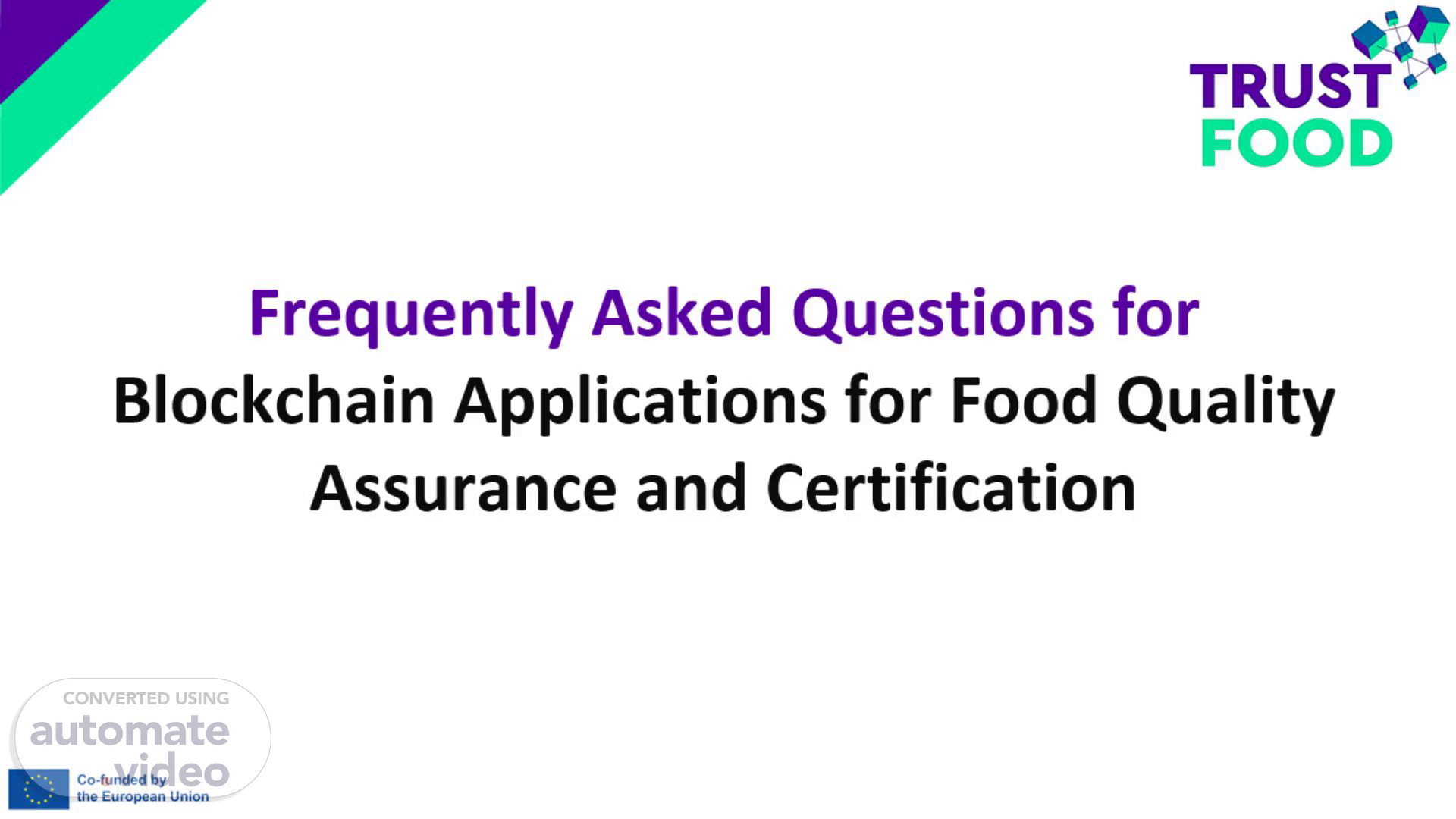Scene 1 (0s)
[Audio] Welcome to the Frequently Asked Questions session for Blockchain Applications for Food Quality Assurance and Certification. We'll be addressing some key questions regarding food supply chains, quality assurance, certification, and the role of blockchain technology in this context..
Scene 2 (17s)
[Audio] What is the Food Supply Chain? "The Food Supply Chain involves various stakeholders such as farmers, manufacturers, distributors, retailers, and consumers. It plays a crucial role in ensuring a steady and efficient flow of food from producers to consumers, also known as 'from farm to fork.' Efficient management of the Food Supply Chain is essential for assuring food quality and certification.".
Scene 3 (44s)
[Audio] What is Food Quality Assurance throughout the Food Supply Chain? "Food quality assurance is a systematic process and set of activities implemented by stakeholders of the Food Supply Chain to ensure that food products consistently meet or exceed established quality standards and specifications.".
Scene 4 (1m 5s)
[Audio] What is Food Certification throughout the Food Supply Chain? "Food quality certification is a process by which an independent third-party organization verifies that a food manufacturer or producer is meeting certain quality standards. These standards cover a wide range of aspects including food safety, nutritional content, environmental sustainability, and animal welfare. Examples of such certifications include Protected Designation of Origin (PDO), Protected Geographical Indication (PGI), and Fair Trade.".
Scene 5 (1m 39s)
[Audio] How Blockchain is Used in the Food Supply Chain? "Blockchain can be used to monitor the Food Supply Chain by creating a digital record of every transaction and event that occurs among stakeholders from farm to fork. Each stakeholder plays a critical role in maintaining food quality and safety, adhering to standards and regulations, and contributing to the overall integrity of the supply chain. Blockchain helps improve traceability, transparency, quality, safety, and efficiency of the food supply chain.".
Scene 6 (2m 12s)
[Audio] How to Map the Food Supply Chain? "To map the Food Supply Chain, you need to identify each stage of it. This includes sourcing or raw material acquisition, production, manufacturing, processing, storage, warehousing, distribution, logistics, retail, and consumption. Once you have the map of your Supply Chain, you need to identify the stakeholders that are part of it.".
Scene 7 (2m 41s)
[Audio] How to Identify the Stakeholders of the Food Supply Chain? "There are two categories of stakeholders: primary and secondary. Primary stakeholders are the key players directly involved in the production and distribution process and impact the quality of the products. They include farmers, manufacturers, wholesalers, logistics companies, retailers, and food safety regulators. Secondary stakeholders are individuals or groups indirectly involved but do not impact the quality of the product. They may include consumers, environmental groups, certification bodies, and financial institutions providing funding.".
Scene 8 (3m 24s)
[Audio] How Stakeholders Interact in the Food Supply Chain? As a Food Supply Chain analyzer, you need to understand the interactions and dependencies among these stakeholders. This usually involves the flow of information, goods, and finances. It is crucial to assess the level of impact and influence each stakeholder has on the quality, safety, and efficiency of the supply chain. Some stakeholders might have more significant roles in ensuring compliance and quality standards..
Scene 9 (3m 53s)
[Audio] What Kind of Data Could a Farmer Provide in a Blockchain? Farmers can provide various types of data to a blockchain, such as: Crop Data: Information about the type and variety of crops being grown, sowing and harvest dates. Field Data: GPS coordinates or location of the farm fields, field size, soil type, and weather conditions. Farming Practices: Types and amounts of fertilizers and pesticides used, water usage, tillage methods, crop rotation, and sustainable practices..
Scene 10 (4m 36s)
[Audio] What Kind of Data Could a Food Processing Company Provide in a Blockchain? Food processing companies can provide: Source Information: Details of raw material suppliers. Batch Numbers and Quantity: Unique identifiers and amounts of raw materials received. Quality Control: Measures and results of quality tests. Processing Steps and Dates: Detailed information on each processing step and respective dates. Equipment Used and Conditions: Types of machinery, temperature, humidity, and storage conditions. Certification Records: Details of certifications like organic, non-GMO, or fair trade..
Scene 11 (5m 19s)
[Audio] What Kind of Data Could a Logistics Company Provide in a Blockchain? Logistics companies can provide: Shipment Details: Type and quantity of goods. Transportation Mode: Details of the transportation method used. Carrier Information: Carriers involved in transportation. Route Details: Planned and actual transportation routes. Shipment Dates: Dates of shipment dispatch and arrival. Temperature and Humidity Logs: Continuous records of temperature and humidity levels during transportation and storage..
Scene 12 (5m 56s)
[Audio] What are the Benefits for the Supply Chain of Olive Oil? "Recording every transaction and event in the olive oil supply chain, from olive cultivation to packaging, ensures that stakeholders can verify the origin, handling, and quality of olive oil at each stage. Moreover, final consumers can verify the organic certification or other quality assurance standards.".
Scene 13 (6m 19s)
[Audio] "Thank you for your attention, and we look forward to addressing any further questions you might have. In case of more questions, please email us at [email protected]. " "We hope this session has provided valuable insights into the use of blockchain for food quality assurance and certification. Feel free to reach out with any additional questions. Have a great day!".
